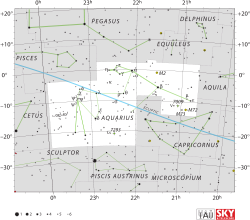| Observation data Epoch J2000 Equinox J2000 | |
|---|---|
| Constellation | Aquarius |
| Right ascension | 23h 06m 40.84483s [1] |
| Declination | −23° 44′ 35.2344″ [1] |
| Apparent magnitude (V) | +4.47 [2] |
| Characteristics | |
| Spectral type | G8 III [3] |
| U−B color index | +0.58 [2] |
| B−V color index | +0.90 [2] |
| Astrometry | |
| Radial velocity (Rv) | +15.2 [4] km/s |
| Proper motion (μ) | RA: +58.86 [1] mas/yr Dec.: −1.74 [1] mas/yr |
| Parallax (π) | 15.08±0.72 mas [1] |
| Distance | 220 ± 10 ly (66 ± 3 pc) |
| Details | |
| Surface gravity (log g) | 3.10 [5] cgs |
| Temperature | 4,900 [5] K |
| Metallicity [Fe/H] | –0.14 [5] dex |
| Other designations | |
| CD−24 17497, HD 218240, HIP 114119, HR 8789, SAO 191651. [6] | |
| Database references | |
| SIMBAD | data |
86 Aquarii (abbreviated 86 Aqr) is a binary star [7] system in the equatorial constellation of Aquarius. 86 Aquarii is the Flamsteed designation, though it also bears the Bayer designation c1 Aquarii. It is faint but visible to the naked eye with an apparent visual magnitude of +4.47. [2] Based upon parallax measurements, the distance to this star is about 220 light-years (67 parsecs ). [1]
The two components of this system have an angular separation of 0.25 arcseconds. [7] The brighter component is a giant star with a spectral classification of G8 III [3] and an apparent magnitude of 4.79. [7] The effective temperature of its outer atmosphere is 4,900 K, [5] giving it the yellowish glow of a G-type star. [8] The fainter component is a star of magnitude 6.77. [7]
